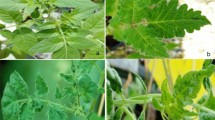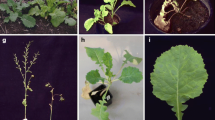Abstract
A virus isolated from lettuce (Lactuca sativa), endive (Cichorium endivia), witloof chicory (C. intybus), and spinach (Spinacia oleracea), and from some weeds was shown to be beet western yellows virus (BWYV) by its host range, particle morphology and serology. It resembled previously described European isolates but differed from American strains in its inability to infectBeta vulgaris, Brassica pekinensis andRaphanus sativus. The most useful host for routine indexing wasCrambe abyssinica. Virus particles in purified preparations stained with uranyl acetate were isometric, ca. 27 nm in diameter. Purified virus reacted with antiserum to an American strain of BWYV in infectivity neutralization gel diffusion and serologically specific electron-microscopy tests.
The field reaction to BWYV of cultivars of lettuce, otherLactuca species and someCichorium species was investigated and differences in symptom expression were observed. On the basis of observations during two seasons BWYV appeared to be widely distributed but seemed of minor economic importance to lettuce growing. It may be a potentially important pathogen of endive and chicory.
Samenvatting
Reeds gedurende enkele jaren trekt in Nederland een vergelingsziekte van sla (Fig. 1 en 2) de aandacht. In 1977 en 1978 werd de ziekte nader bestudeerd en ook waargenomen in andijvie, witlof (Fig. 3) en spinazie. Uit zieke planten van deze vier gewassen en uit de onkruiden herderstasje en kruiskruid, groeiend in de buurt van de zieke sla, kon doorMyzus persicae op persistente wijze een virus worden overgebracht. Het werd op grond van zijn waardplantenreeks (Tabel 1), deeltjesmorfologie (Fig. 4A) en serologie (Fig. 4B) herkend als het in de USA beschreven ‘beet western yellows virus’ (BWYV).
Het Nederlandse virus komt overeen met in andere landen gerapporteerde Europese isolaten van het virus, maar verschilt van Amerikaanse doordat het niet in staat is om biet, chinese kool en radijs te infecteren. Daarom is voor het virus door Bos en Ashby (1978) de Nederlandse naam slavergelingsvirus ingevoerd. De meest geschikte indicatorplant voor routinetoetsing isCramble abyssinica (Tabel 2). De reactie van herderstasje varieert al naar individu van nagenoeg letaal tot vrijwel symptoomloos (Fig. 5).
In gedeeltelijk gezuiverde preparaten bleken de deeltjes bolvormig te zijn en ca. 27 nm in diameter (Fig. 4A). Zulke preparaten reageerden met antiserum tegen een Amerikaanse stam van het virus (BWYV) in toetsen die gebruik maken van infectieneutralisering, gel-diffusie en serologisch-speciefieke elektronenmikroskopie. Bij laatstgenoemde techniek werd een fraaie deeltjesklontering waargenomen (Fig. 4B), die ontbrak na incubatie van gezuiverd virus met een antiserum tegen het niet verwante kersebladrolvirus (Fig. 4C).
Bij veldwaarneming in 1977 van 20 slarassen, waarbij tot 60% van de planten van één ras werden aangetast, bleken twee rassen niet of weinig vatbaar (Tabel 3). Bij inoculatie in de kas bleken ze echter volledig vatbaar. In 1978 werd een aantal soorten en rassen vanCichorium enLactuca blootgesteld aan natuurlijke en aan kunstmatige infectie. BehalveC. intybus ‘Groenlof IVT’ waren allen vatbaar, ookL. sativa ‘Gallega de Invierno’,L. serriola enL. virosa.
Het virus lijkt algemeen voor te komen. Meestal is de infectiegraad niet hoog. Vanwege de lange incubatieduur in sla is het virus in dat gewas bij de hier toegepaste teeltwijze waarschijnlijk van geringe betekenis. Het lijkt echter een potentieel belangrijk pathogeen voor andijvie en witlof.
Similar content being viewed by others
References
Ashby, J.W. & Huttinga, H., 1979. Purification and some properties of pea leafroll virus. Neth. J. Pl. Path. 85:113–123.
Bos, L. & J.W. Ashby, 1978. Vergelingsvirusziekten, een ware pest (in Dutch: Yellows virus diseases, a real plague). Gewasbescherming 9:115–130.
Duffus, J.E., 1960. Two viruses that induce symptoms typical of ‘June yellows’ in lettuce. Pl. Dis. Reptr 44:406–408.
Duffus, J.E., 1964. Host relationships of beet western yellows virus strains. Phytopathology 54:736–738.
Duffus, J.E., 1972. Beet western yellows virus. C.M.I./A.A.B. Descriptions of Plant Viruses No. 89, 4 pp.
Duffus, J.E., 1977. Aphids, viruses and the yellow plague. In: K.F. Harris & K. Maramorosch (Eds), Aphids as virus vectors. Academic Press, New York, San Francisco, London: 361–383.
Duffus, J.E. & Gold, A.H., 1965. Transmission of beet western yellows virus by aphids feeding through a membrane. Virology 27:388–390.
Duffus, J.E. & Russell, G.E., 1970. Serological and host range evidence for the occurrence of beet western yellows virus in Europe. Phytopathology 60:1199–1202.
Duffus, J.E. & Russell, G.E., 1972. Serologycal relationship between beet western yellows and turnip yellows viruses. Phytopathology 62:1274–1277.
Duffus, J.E. & RUssell, G.E., 1975. Serological relationship between beet western yellows and beet mild yellowing viruses. Phytopathology 65:811–815.
Heinze, K., 1967. Die Vergilbungskrankheit der Kohl- und Wasserrübe als Krankheitsursache auf Zierpflanzen. Mitt. Biol. Bundesanst Berlin Dahlem 121:132–139.
Lecoq, H., 1977. Caractérisation d'une nouvelle maladie de la laitue en France due à un virus du groupe du beet western yellow virus. Annls Phytopath. 9:98.
Milne, R.G. & Luisoni, E., 1977. Rapid immune electron microscopy of virus preparations. In: K. Maramorosch and H. Koprowski (Eds), Methods in Virology 6: 265–281.
Nagi, A., 1975. Beitrag zum vermutlichen Vorkommen des Beet Western Yellows Virus (BWYV) in Europa. Phytopath. Z. 82:146–151.
Rochow, W.F., 1972. The role of mixed infections in the transmission of plant viruses by aphids. Ann. Rev. Phytopathol. 10:101–124.
Russell, G.E., 1965. The host range of some English isolates of beet yellowing viruses. Ann. appl. Biol. 55:245–252.
Russel, G.E. & Dufus, J.E., 1970. An aphid-transmitted yellowing virus disease of lettuce in England. Pl. Path. 19:148–149.
Vanderwalle, R. & Roland, G., 1951. Contribution à l'étude de la jaunisse du navet. Parasitica 7:14–15.
Watts, L.E., 1975. The response of various breeding lines of lettuce to beet western yellows virus. Ann appl. Biol. 81:393–397.
Author information
Authors and Affiliations
Additional information
Guest research worker, Plant Diseases Division, DSIR, Private Bag, Christchurch, New Zealand, with financial assistance from the International Agricultural Centre, Wageningen, and Ministry of Education and Science, The Hague.
Rights and permissions
About this article
Cite this article
Ashby, J.W., Bos, L. & Huijberts, N. Yellows of lettuce and some other vegetable crops in the Netherlands caused by beet western yellows virus. Netherlands Journal of Plant Pathology 85, 99–111 (1979). https://doi.org/10.1007/BF01982972
Accepted:
Issue Date:
DOI: https://doi.org/10.1007/BF01982972




